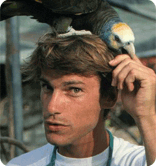Greys at Play: What is normal?

My 1 year old Congo African Grey (Bruno) loves to play. I often see him swinging on a rope upside down, making funny noises and pretending to attack toys hanging from the cage ceiling (or rather “defending” himself from the toys that are trying to “attack” him). When he is on the top of his cage, he loves to throw objects (like a small rubber ball) into the air, then run and pick it up, then throw again, run and pick it up and throw again and again.
My question is: is this type of active physical play normally seen in wild nature?
I know that parrots in the wild engage in play fights or flights to practice predator evasion. but that is more like a social play. Do wild African Greys play the same way as Bruno does? I heard an opinion that unless the bird is very well fed, it shouldn't be expending energy engaging in play like that. Every bit of stored energy should be used to obtain food, shelter and in other survival activities. Is that true?
Thank you, Lena

Dear Lena, First of all, anytime a parrot exhibits play-like behavior, that's a very good sign indeed as it indicates that the bird is feeling good about life. After all, depressed, malnourished, or sick birds are really unlikely to be inspired to play.
Wild parrots, especially young birds in their first few years, are especially likely to exhibit behaviors which for us look like play. To the best of my knowledge, no one has spent enough time around wild Grey Parrots to have a really clear sense for how common this is in birds of various ages. Hopefully in the coming years, that will change and we'll get more of this kind of detailed information about their lives in the wild.
Very few wild animals are on such a tight energy budget such that expending some energy on play behavior would be of concern. Parrots in particular tend to feed on super abundant and very rich food. For example, one of the Grey's favorite fruits in the wild contains about 50% fat, so some of their preferred food items are extremely rich. Generally wild parrots feed a short period in the morning, and then spend most of the day resting, and then feed again in the mid-late afternoon. They have a lot of free time and should have ample energy for play should they be so inclined.
In any event, the more your bird spends time in play mode, the better. And the more different kinds of play you can introduce him to now while he's willing to try new things, the more likely he'll retain some of these playful, healthy activities later in life.
Good luck!
Jamie

































